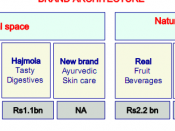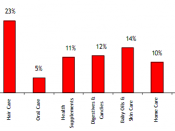Dabur India Limited:
Brand Architecture
�
Branded House: Dabur India Limited
Dabur India Ltd. started off as a small pharmacy, but has grown and expanded into a powerful FMCG force in the Indian market. It is right up there in the mix with the FMCG moguls like HUL, P&G etc. in terms of sales, revenue and market penetration. Dabur has always been an organisation hinged on strong R&D and product development adhering to stringent quality norms. The Indian connection has helped Dabur in becoming a household name in the strongly competitive FMCG sector. It is, today, the fourth largest FMCG company in India.
Brand Architecture
Dabur has traditionally followed a Branded House form of architecture for its brands. Every product from the Dabur stable carries the house brand name along and the company has been insistent on this facet. Although with its recent acquisitions, certain brands have retained their brand names to continue with existing consumer base.
Dabur has the largest herbal and natural products portfolio. There are five master brands - Dabur (Ayurvedic health care), Vatika (Premium hair care), Réal (Fruit juices and beverages), Hajmola (Tasty digestives) and Fem (Fairness bleaches and skin care). Initially positioned as an Ayurvedic products expert, Dabur has made its foray into personal care, food and beverages, home care and health supplements. This change in strategy has helped Dabur in becoming a force in the FMCG industry, thus coming away from its "Doctor brand" image and creating a new niche for itself with its indigenous roots. Dabur has managed to bring forth its trust from the phase of Ayurvedic products to its current new -generation upbeat positioning, enabling the customer to believe that the standard and quality of the products will be top-notch as ever.
In order to focus on categories of importance,


